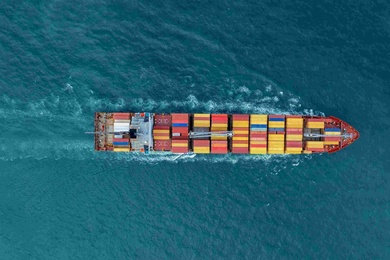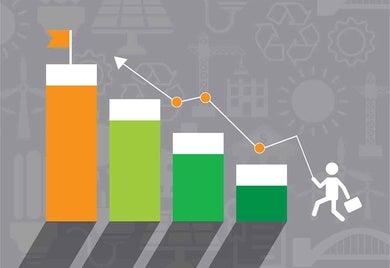Blogs Navigation
Sustainable BusinessRecent posts

How to Measure Job Creation in Development Projects
Development finance institutions need to know how many jobs their investments support and create, yet obtaining reliable data is a challenge. To address this, IDB Invest is piloting a new framework to measure the contribution of development project portfolios to employment in Latin America and the Caribbean.

In the Face of Sustainability Challenges, Strong Governance Begins in the Boardroom
Boards of Directors must lead mitigation strategies, embedding long-term planning and innovation into risk oversight. IDB Invest empowers directors to transform climate governance into resilience, opportunity, and competitive advantage across diverse sectors.

36,000 Transactions That Transformed Regional Trade
Since 2005, the Trade Finance Facilitation Program has promoted financial inclusion, trade resilience, and regional integration among countries through financial solutions, strengthening local capacities, and promoting sustainability.

What is a B-bond?
With a nearly $200 billion a year financing gap, it is virtually impossible for the development banks in Latin America and the Caribbean to close it alone. However, there is good news.

SMEs and the Challenge to Export
Small and medium-sized enterprises (SMEs) are an essential part of a dynamic and healthy economy. Their increase in number and growth advances competition and strengthens the entrepreneurial ecosystem, with a positive and significant impact on innovation and aggregate productivity. SMEs represent close to 90% of the companies in a typical Latin American or Caribbean country and employ most of the labor force (close to 70%). They also tend to create a substantial portion of new jobs; although many of these jobs do not survive, the net effect tends to be positive. However, the region’s SMEs show a low level of internalization (learning by doing) compared to their peers in the developed countries or other emerging economies, or even compared to large companies in the same sector and country. Exporting: Relevance and challenge There is abundant evidence showing that Latin American and Caribbean countries are behind developed countries, due to the productivity gap. Improving productivity is essential for the region’s economies and expanding exports can help. First, international trade produces a reallocation of resources from less productive companies and sectors to more productive ones. Second, by exporting companies learn (learning-by-exporting) and innovate, which is reflected in significant efficiency gains. Finally, international trade affects the incentives for investment in activities that promote technological dissemination and generates spillover effects in international knowledge. However, companies face many obstacles when they try to enter external markets. They have to contact clients abroad, identify business opportunities, learn about distribution channels and administrative procedures, among other aspects. All these activities generate a wealth of information that can be used by other companies at no additional cost (or lower cost). This scenario generates a problem of free riding in the search for foreign buyers, given that the pioneer uncovers highly valuable information that can be used by other companies to imitate their behavior. In this context, where the private returns of the forerunners are less than the social returns, market incentives tend to lead to a suboptimal level of investment in the exploration of international markets. Thus, the existence of information externalities can negatively affect companies’ internalization process and provides a key rationale for encouraging companies to export. It’s even more difficult for SMEs In addition, SMEs in Latin America and the Caribbean tend to face restrictions in various areas of business — due to various market failures and failures in coordination — limiting their internalization. These areas are primarily access to credit, the intensity of innovation, capacities (human capital) and the organizational structure. SMEs in the region have limited access to credit, due to information asymmetry problems — financial institutions usually do not have the information they need to evaluate and monitor SMEs’ projects, which can cause problems of moral hazard — but also because financial products are not suited to SME needs, particularly due to scale problems related to the fixed costs of the lending process and the lack of long-term financing. In addition, SMEs generally do not have (sufficient) collateral, while their access to credit is highly dependent on collateral and not so much on expected returns as in the case of large companies. The nature of knowledge as a public good, information asymmetries and the lack of coordination particularly limit SMEs’ innovation and competitiveness both domestically and internationally. On the other hand, these companies tend to lack capacities — qualified and experienced personnel — for the export process: identifying, selecting and obtaining information on external markets, designing and implementing marketing strategies, and developing contracts overseas. SMEs have limited knowledge on exportable products and the underlying factors that determine international competitiveness (e.g., packaging, quality regulations, standards, etc.). Also, SMEs face other specific barriers specific related to export activities such as language, paperwork, billing, and sales management. Lastly, SMEs have characteristically weak corporate governance and management and business structures even though in most cases these are companies with personalized and traditional organizational hierarchies linked to a single owner or family. All these factors profoundly limit the export capacity and competitiveness of these companies. A model helping Argentine SMEs to export In 2002, the Fundación Banco Credicoop, with support from the IDB Group, created the Diverpymex program. The objective of this program is to help non-exporting SMEs to successfully enter export markets and exporting SMEs to increase their exports, whether through consolidation and/or diversification. The program consists of three stages that consider the phases in the export development process: Evaluating the company’s export potential: Analyze its skills and competence for operating in international markets. A program coordinator and a consultant visit the company and gather information on its organization, operations and products, and hold meetings with the managers to evaluate the company’s entrepreneurial spirit in terms of export activities and potential commitment to incorporate an intern (in the absence of qualified staff) and to make the investments necessary to develop its exporter profile. Developing an export plan: The company, with technical assistance from the consultant, researches and selects potential markets and clients, and decides which are best suited to them. It also establishes objectives, develops a budget, plans how the exports will be managed, and analyzes financial, logistical, and staffing requirements, as well as other aspects of the export process. Implementing the plan: The company undertakes planned actions in foreign markets. At this point, training and technical assistance activities are carried out on specific subjects that arise during the process of market penetration such as shipments and insurance, quality and environmental standards, design and packaging, marketing channels, tax legislation, and others. How do we evaluate the impact and what have we learned? In a recent study done by IDB Invest, we evaluated the Diverpymex program’s impact on SME’s export behavior, growth and productivity. The study analyzes the dynamics and sequence of the effects, allowing for inferences regarding the mechanisms through which the program affects the companies’ performance. What were the main results? The program has a positive and significant impact on SME’s export behavior, growth and productivity. The positive effect on the likelihood of exporting and entering new markets is significantly greater in the short term, which confirms the importance of high costs for entering foreign markets. The positive effect on the amount of exports, for companies that were already exporting, appears over the medium term, and it is related to the resolution of more specific information barriers to markets and products, allowing these companies to grow and consolidate their efforts in export markets. Finally, the program increases the company’s productivity in the long term, indicating that SMEs achieve efficiency gains due to a learning-by-exporting process. Subscribe to receive more content like this! [mc4wp_form]

Mining Bitcoin in Latin America: opportunities … and dangers!
The discovery of the first gold nuggets in General Sutter’s sawmill became a true “gold rush” in the United States. In the mid-19th century, California attracted a generation of immigrants and adventurers looking to become wealthy in the blink of an eye, with their picks and shovels. However, to achieve this dream it was necessary capital, energy and luck. In addition, this adventure involved greater economic and physical risks. According to my family story, my great-granduncle was among those enticed by the gold fever, leaving Ireland behind with its poor potato harvests and economic policies dictated from London. Like most of immigrants, his dreams of a golden wealth soon were vanished. Nonetheless, over the following decades, California would become a vibrant state where film industry, commerce, aeronautics, and more recently, technology, would thrive. The “gold rush” and the determination of those pioneers were the initial catalysts for California’s vibrant economy that today continues to spread wealth and benefits on a global scale. Mining Bitcoin Today we live in a world where the real and the virtual are merging. In a world where data is considered the new oil it is not surprising that the mining trend is data mining, more specifically, Bitcoin mining. But, what is Bitcoin mining? Bitcoin is a cryptocurrency based on Blockchain technology. This technology is nothing more than a long chain of records; a digital, decentralized, immutable, sequential, and encrypted “ledger.” The chain is not controlled by any central authority but by an enormous computers’ network in charge to verify that the information saved in the component blocks is consistent. The key for the security of the chain of blocks is a hash, a cryptographic mathematical bit that makes the links among the blocks practically unbreakable. Returning to Bitcoin, the cryptocurrency originated from a “mining” process in which “miners” compete to solve complex mathematical problems using computers that run algorithms. Every ten minutes, whoever solves the problem and validates the chain with at least 51% confirmed by the miners is the winning miner. The new chain is then encrypted with a new block and copied in all the computers in the network. Obviously, the reward for the winning miner is paid in Bitcoin. Not a bad deal, considering that the value of a Bitcoin has increased from $700 to $16,789 in the last year alone (value at December 14th, 2017). What do we need to mine Bitcoin? Like gold miners a century and a half ago, a digital miner requires some capital, an Antminer S9, “plug and play” hardware; enough energy to run the computers day and night; and a great deal of luck to figure the solution based on computational capacity only. These days, the competition for Bitcoin mining is brutal and inefficient without economies of scale. Besides, like gold nuggets in California that became increasingly scarce, the total number of Bitcoins to be mined is fixed. American curiosities Unlike the “gold rush,” to mine Bitcoin there is no need to go to Silicon Valley. Digital technologies are geographically agnostic, which is beneficial for those who are most desperate to find solutions to their pressing issues. In Venezuela, the case of Bitcoin mining is emblematic and there are those who believe it could be the first country in the world to adopt Bitcoin as currency. The country suffers from high inflation and a weakened currency. But if you add the fact that energy is practically free in Venezuela, the country has some of the ingredients to become a paradise for miners. However, the indiscriminate use of energy has already caused significant tensions between the miners and the authorities. In addition, in the United States, the Bitcoin entrepreneur, Charlie Shrem, was arrested, accused of conspiracy for facilitating the use of cryptocurrency on the Silk Road platform. On one hand, it is evident that there is demand for a digital, credible unit of value free of interference from the central authorities. On the other hand, this logically creates tension with the traditional players (i.e. governments, central banks) and the desire to define basic game rules, in a context where reality advances at a faster than the ability to regulate it. Meanwhile, the Bitcoin fever continues, and the Blockchain ecosystem is still on the front pages. The Latin American company, Ripio, with its business model of person-to-person loans, has raised $37 million selling tokens through an ICO (“Initial Coin Offering”)! The “gold rush” drew adventurous immigrants to California’s mountains. As happened with the Irish, they were driven out by bad administrations and various misfortunes, and were willing to risk it all. As a result, California’s economy is one of the most dynamic in the world. Today, the Bitcoin fever is attracting another type of miner, a digital miner. Some will be successful and make their fortune from the valued currency. In certain countries, some of them will be imprisoned, accused of wasting electricity. But for many, cryptocurrency mining is seen as one of the gears of a new technology that over the long term may become an alternative to certain fiduciary currencies, making the digital economy even more efficient. Mind you, miners and investors, proceed with caution! Subscribe to receive more content like this! [mc4wp_form]

What have we learned after a decade of public-private partnerships in Latin America and the Caribbean?
Until the end of 1990, Latin America and the Caribbean was the region with the greatest proliferation of public-private partnerships (PPPs). At that point, investments plummeted, partly due to negative reactions caused by its deficient implementation. In 2005, thanks to the joint efforts of public, private sector, and multilaterals, PPPs became again a widely used tool. Driven by the fall in commodities prices, the increase of fiscal deficits, and the improved conditions for implementing PPPs, many countries established specific institutions and strengthened their regulations. As a result, investments through PPPs grew almost five times, from US$8 billion in 2005 to US$39 billion in 2015. In barely one decade, Latin America and the Caribbean has registered US$361.3 billion in investments for almost 1,000 infrastructure projects through PPPs, primarily in the energy and transport sectors. PPPs potentially can help to overcome some of the public-sector limitations but they also raise concerns. Large-scale projects involve many technical, financial, environmental, and social risks. PPPs demand greater attention to risks assignment, conflict resolution, and the analysis of “value for money.” They also require institutional development that takes time to consolidate and, when it is poorly done, can even increase costs and reduce services or its quality. Transparency is also key to mitigate the risk of corruption, which has become more visible in Latin America and the Caribbean in recent years. In this context, multilateral development banks can play a key role supporting the development of proper environments for attracting private investment, supporting independent projects preparation, and helping to bridge financing gaps. These banks, also have a potential comparative advantage: their ability to be directly involved with the public and private sectors. 10 keys for strengthening the multilaterals’ support for PPPs The Office of Evaluation and Oversight has reviewed IDB Group support for PPPs in infrastructure projects at three levels: favorable environment, project preparation and financing, besides other development banks’ experience. These banks financed a small (3%) but considerable proportion of PPP’s investment in Latin America and the Caribbean. The IDB Group provided the most financing (35%), among these entities, with 145 approved operations for US$5.8 billion between 2006 and 2015. Based on our conclusions, the Evaluation of Public-Private Partnerships in Infrastructure, published last March presents 10 recommendations: Specific diagnostics: identify and evaluate potential demand for PPPs by country, including analysis of infrastructure needs in the sector, PPPs environment, fiscal limitations and risks, and type of support needed by the governments. Priorities: include a general framework to determine which countries and sectors need support, type of support needed, and define priorities. Focal point: establish a PPP focal point with sufficient authority and resources to promote collaboration among all parties involved in the institution. Capacities: do an inventory of existing capabilities, identify what is missing, and try to attract and maintain the necessary capabilities. Incentives: reform the incentives, granting rewards when private investors’ funds are mobilized and creating incentives for collaboration. Advisory services: Analyze infrastructure projects in the pipeline, and advise countries regarding the most suitable delivery model, regardless of the sector that will originate the operation. New products: Explore the use and development of new financial and advisory products tailored to the countries’ specific needs, such as local currency financing, advisory services, specific instruments supporting subnational governments, and project preparation mechanisms. Results framework: examine the value for money of PPPs operations, the quantity and quality of the services provided, costs to the taxpayer and the user and its sustainability, in addition to evaluating whether critical environmental and social objectives have been met. Knowledge: Design a specific knowledge strategy on PPPs to systematically capture and file the results of operations and lessons learned. Lessons learned:Systematically incorporate lessons learned by your own organization and other banks on the design and implementation of new PPP operations. Many Latin American and Caribbean countries with solid capacity for implementing PPPs have an extensive list of potential projects, and practically all the larger countries have an infrastructure investment program in which PPPs play a fundamental role. Moreover, since in some of the region’s most important economies the ratio between private investment and gross domestic product (GDP) continues to be low, there is a considerable margin for new projects. The development banks are well positioned to play a fundamental role in these future PPPs, providing support to ensure their suitability in economic, environmental, and social terms, to generate favorable environments that attract private investments, and to close the financing gaps. Only if these recommendations are implemented will we be able to contribute to a wave of successful PPPs and avoid the negative reactions we have seen in the past. The IDB Group has accepted the recommendations and is ready to put them into practice. Subscribe to receive more content like this! [mc4wp_form]

The Floods of 2017: How can the private sector mitigate the impact of natural disasters
There are many theories to explain the current trend of increasing frequency and magnitude of extreme events, but it seems obvious that there is a correlation with increasing average temperatures. Many argue that the world is already experiencing the consequences of climate change and that even if the increase on average world temperature is kept under 2 degrees Celsius, countries will have to adapt to a wider range of natural disasters. During 2017 the world witnessed the occurrence of severe floods from China to Canada. As we wrote this article, Italy was facing its second season of severe flooding. Latin America and the Caribbean was no exception, and Peru was particularly affected by this phenomenon. The floods in the Andean country destroyed 115,000 homes, leaving almost 180,000 homeless, over 110 people were killed, more than 350 were seriously injured, and over 2,500 kilometers of roads have been devastated. The region is particularly vulnerable to the occurrence of floods as it is the most impacted by El Niño. Additionally, due to its high urbanization rate, the impact of floods to cities and urban infrastructure are often devastating. While estimates of necessary annual investments to manage floods in the region vary, given the constraints on fiscal spending, the full burden of this cannot be met by governments alone. Therefore, the private sector has a key role to play, that involves both the development of software as well as hardware. Insurance: A key software for mitigation On the soft side, alternatives to avoid or mitigate the impact of severe floods include flood insurance, payment for environmental services, better flood assessment and warning systems, ecosystems planning, and zoning, among others. All these services can be provided by the private sector through the development of policies and adequate incentive frameworks. For example, unleashing private sector insurers to offer products in Latin America is no easy task but it can bring about a stream of benefits. Insurance is a fundamental component in any strategy of adaptation to natural disasters. As illustrated in a paper by the Global Facility Disaster Reduction and Recovery, flood insurance: Increases resilience against residual risks that cannot be prevented or mitigated Incentivize engagement and investment in risk mitigation measures Reduces pressure on the fiscal budget from natural disasters Private sector participation is driven by a complete shift toward risk-based rates, and more accurate mapping which in turn provide correct economic incentives both in urban as well as in rural areas (agriculture in particular). The private sector can apply innovation and technology to improve early warning systems. The earlier we can identify where storms are likely to hit, the better we can target efforts to minimize damages. In the Netherlands, for example, Siemens has created the concept of “smart levees” by implementing a monitoring system that uses sensors to gauge water pressure, temperature and shifting water profiles. This allows the identification of stretches of levees that are at higher risk of being breached. Innovative solutions for better hardware With respect to hardware, the most obvious opportunities relate to retrofitting and developing infrastructure that is more resilient, and can better perform under extreme conditions. The vulnerability of existing infrastructure was evident during the occurrence of natural disasters in 2017, and the private sector can bring capital, innovation, management systems, and technology. Following hurricane Maria devastation in Puerto Rico, Tesla’s Elon Musk, offered to green and revamp energy generation in the island through the installation of solar systems and high-tech batteries. Bold ideas and innovation will be necessary to assist Latin America and the Caribbean in adapting to the impacts of climate change. In doing so, a vital role of governments is to develop policies and regulatory frameworks that allow the creation of new business models and provide incentives for companies to invest on climate smart infrastructure. For instance, building and financing (public/private) business models for urban drainage transformation in megacities represents a gigantic opportunity to foster investments that will significantly improve the quality of life of millions of urban residents in the region. At IDB Invest we can draw lessons from our vast experience in the region that combined with disruptive technologies, and a menu of financing instruments can offer unique value propositions to our clients. We embrace the opportunity to work with private companies all over Latin America and the Caribbean in the development of innovative models that can contribute to better management of floods and other natural disasters in our countries. Subscribe to receive more content like this! [mc4wp_form]

Can your company be a sustainability champion?
Long-term financial performance is directly proportional to good governance, environmental stewardship and social responsibility, but you probably already knew that. If so, then you should also be able to prove it and measure it, because nowadays a vision is not enough to convince your clients. “What gets measured gets managed.”- Peter Drucker (known as the father of modern management) The Problem What if I tell you that purpose is not enough and that measurement encourages ambition? When I look back to my early school days I remember some of the —silly, but edifying— competitions with my friends and classmates. The range of our “high-performance rivalries” went from copying text from the chalkboard into our notebooks in the fastest possible time, comparing math grades at semester end, scoring backheel goals in a soccer match and much more. Measuring and comparing records was the motivation for continuous improvement to beat my own achievements and those of my fellow mates. But what does that have to do with sustainability? Everything. Measuring progress using a comprehensive yet meaningful list of indicators is the core foundation to turn sustainability into a competitive advantage. The Solution: Measuring, reporting, disclosing. Year after year more corporations perceive the competitive edge existent in being part of a sustainability rating and index. According to the Governance & Accountability Institute, 82% of S&P 500 Companies published Corporate Sustainability reports in 2016. In this context a sustainability index is a barometer to measure the success level of a company. It acts not only as an MRI to detect environmental, social and governance issues, but also indicates the economic relevance of sustainability parameters for corporate management and investors. But we need to go further. A recent report from KPMG on corporate responsibility and sustainability indicates that simply linking corporate responsibility activities thematically to the United Nations Sustainable Development Goals (SDGs) is not enough. People want to know how companies are contributing to achieve the goals, and what is the actual impact. Not only does civil society want this information, but also several large institutional investors are exploring how to align their investment approaches with the SDGs. This is why full transparency and full disclosure are key. The economic relevance of sustainability parameters for corporate management and investors are manifold. A study by the University of Oxford showed impressive results on how disclosing sustainability practices can drive financial outperformance. For example, 90% of the studies on the cost of capital indicate that sound environmental, social and governance (ESG) standards lower the cost of capital of companies. If only there were a specific tool for companies in Latin American and the Caribbean to measure and compare performance of environmental, social and governance (ESG) indicators…THERE IS. IndexAmericas IndexAmericas is the world’s first sustainability index exclusive to Latin America and the Caribbean region. Created by the IDB Group (Inter-American Development Bank and IDB Invest) in partnership with Thomson Reuters, S-Network Indexes and Florida International University, IndexAmericas recognizes the top 100 publicly traded companies operating in the region and leading the way in sustainability. It also identifies the top 30 sustainable companies headquartered in the region. IndexAmericas focuses on four key dimensions: environment, society, corporate governance and development (ESGD). Different from other sustainability indexes, IndexAmericas assesses publicly data rather than using a self-assessment questionnaire. It is a management tool that measures more than 400 ESG indicators and 15 IDB Group proprietary key development indicators to evaluate corporate sustainability. I think professor Peter Drucker would be proud to see this achievement. Want to learn more? Visit IndexAmericas [gallery type="slideshow" size="full" link="none" ids="8440,8441,8443,8442"] Subscribe to receive more content like this! [mc4wp_form]


